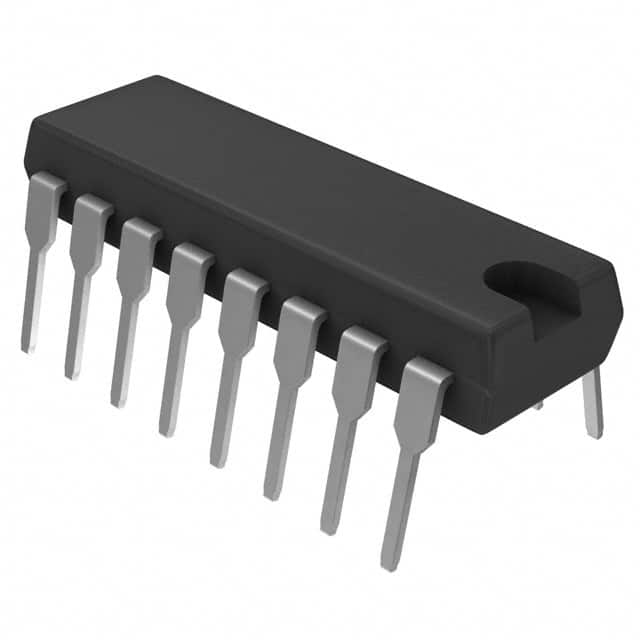CD74HCT157E
Product Overview
- Category: Integrated Circuit (IC)
- Use: Data Selector/Multiplexer
- Characteristics: High-Speed, CMOS Logic, Quad 2-Input Multiplexer
- Package: DIP (Dual In-line Package)
- Essence: The CD74HCT157E is a versatile multiplexer IC that allows the selection of one out of four data inputs to be routed to a single output.
- Packaging/Quantity: Available in tubes or reels, with varying quantities depending on the supplier.
Specifications
- Supply Voltage Range: 4.5V to 5.5V
- Input Voltage Range: 0V to VCC
- Output Voltage Range: 0V to VCC
- Operating Temperature Range: -40°C to +85°C
- Propagation Delay Time: 15ns (typical)
- Maximum Quiescent Supply Current: 4µA
Detailed Pin Configuration
The CD74HCT157E has a total of 16 pins, which are assigned specific functions as follows:
- A Input 1
- B Input 1
- C Input 1
- D Input 1
- GND (Ground)
- Y Output
- E Enable Input
- F Input 2
- G Input 2
- H Input 2
- VCC (Supply Voltage)
- I Input 3
- J Input 3
- K Input 3
- L Input 3
- NC (No Connection)
Functional Features
- Quad 2-Input Multiplexer: Allows selection of one out of four data inputs.
- High-Speed Operation: Provides fast switching times for efficient data routing.
- CMOS Logic: Utilizes complementary metal-oxide-semiconductor technology for low power consumption and high noise immunity.
- Enable Input: Allows the user to enable or disable the multiplexer as needed.
Advantages and Disadvantages
Advantages: - Versatile data selection capabilities - High-speed operation - Low power consumption - Wide operating temperature range
Disadvantages: - Limited to 2-input multiplexing - Not suitable for applications requiring more than four data inputs
Working Principles
The CD74HCT157E operates based on the principles of digital logic. The inputs A, B, C, and D are used to select one of the four data inputs, while the E input enables or disables the multiplexer. When enabled, the selected data input is routed to the output pin Y. The CMOS technology ensures efficient operation with minimal power consumption.
Detailed Application Field Plans
The CD74HCT157E finds applications in various fields, including:
- Data Routing: Used in digital systems to selectively route data from multiple sources to a single destination.
- Multiplexing: Enables the selection of different data sources for processing or transmission.
- Control Systems: Employed in control circuits to switch between different control signals based on specific conditions.
- Communication Systems: Facilitates data selection and routing in communication equipment such as routers and switches.
Detailed and Complete Alternative Models
- SN74HCT157: Similar quad 2-input multiplexer IC from Texas Instruments.
- MC74HCT157: Equivalent multiplexer IC from ON Semiconductor.
- 74HC157: Quad 2-input multiplexer IC from NXP Semiconductors.
These alternative models offer similar functionality and can be used as replacements for the CD74HCT157E depending on availability and specific requirements.
Word count: 409 words
قم بإدراج 10 أسئلة وإجابات شائعة تتعلق بتطبيق CD74HCT157E في الحلول التقنية
Sure! Here are 10 common questions and answers related to the application of CD74HCT157E in technical solutions:
Question: What is CD74HCT157E?
Answer: CD74HCT157E is a quad 2-input multiplexer with complementary outputs, commonly used in digital logic circuits.Question: What is the operating voltage range for CD74HCT157E?
Answer: The operating voltage range for CD74HCT157E is typically between 4.5V and 5.5V.Question: What is the maximum input current for CD74HCT157E?
Answer: The maximum input current for CD74HCT157E is typically 1µA.Question: Can CD74HCT157E be used as a demultiplexer?
Answer: Yes, CD74HCT157E can be used as a demultiplexer by connecting its inputs appropriately.Question: What is the maximum propagation delay for CD74HCT157E?
Answer: The maximum propagation delay for CD74HCT157E is typically 18ns.Question: Can CD74HCT157E drive LEDs directly?
Answer: No, CD74HCT157E cannot drive LEDs directly. It requires additional components like current-limiting resistors.Question: What is the power dissipation of CD74HCT157E?
Answer: The power dissipation of CD74HCT157E is typically 20mW.Question: Can CD74HCT157E be used in high-speed applications?
Answer: Yes, CD74HCT157E can be used in high-speed applications due to its low propagation delay.Question: Is CD74HCT157E compatible with TTL logic levels?
Answer: Yes, CD74HCT157E is compatible with TTL logic levels and can be used as a drop-in replacement for TTL devices.Question: Can CD74HCT157E be cascaded to increase the number of inputs?
Answer: Yes, multiple CD74HCT157E devices can be cascaded together to increase the number of inputs in a circuit.
Please note that these answers are general and may vary depending on specific datasheets and manufacturer specifications.


